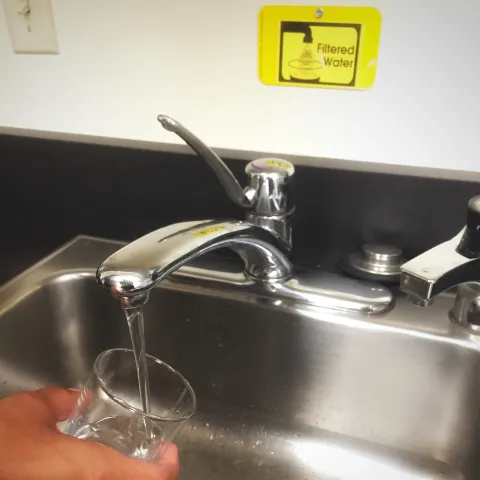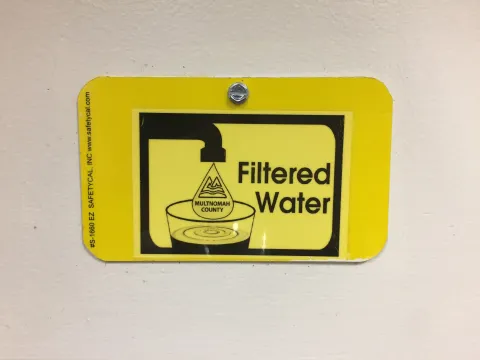For many of us, having safe, clean drinking water readily available at the tap is taken for granted. But ensuring that the drinking water at Multnomah County buildings really is safe and clean is anything but taken for granted by a team of dedicated County employees.

Under the Department of County Assets (DCA), the Compliance Section within Facilities and Property Management Division (FPM) has long facilitated water testing procedures that go above and beyond what is required by the Environmental Protection Agency (EPA), and division staff are committed to ensuring that the people who come to County facilities every day can rely on the drinking water provided.
FPM’s internal Drinking Water Quality Testing Policy establishes how water in facilities owned or maintained by the County is to be collected and tested, as well as what actions are to be taken if test results exceed outlined action levels.
PBS Engineering and Environmental, instrumental in developing this policy, also collects the samples, which are then analyzed by a third-party laboratory. Analysis includes test results for compounds of concern as outlined in the policy which include lead, copper, coliform bacteria, E. coli, and other potential site-specific contaminants as determined.
Buildings that have 24/7 occupancy and/or that require accreditation documentation, including health clinics and jails, are tested annually. At all other locations, select taps and water fountains are tested every three years. In larger buildings, sample locations are rotated since they likely have multiple fixtures. Water quality reports for all County facilities tested are available at the Building and Property Data page by selecting a building and then clicking on “View Water Quality Reports.”
Since 2005, a total of 734 drinking water samples have been collected County-wide:
2005-06
- 41 samples collected from 12 buildings
- 4 exceedances (4 bacteria)
2006-07
- 74 samples collected from 49 buildings
- 5 exceedances (4 bacteria, 1 copper)
2007-08
- 21 samples collected from 10 buildings
- No exceedances
2008-09
- 95 samples collected from 49 buildings
- 16 exceedances (8 bacteria, 4 copper, 4 lead)
2009-10
- 24 samples collected from 9 buildings
- No exceedances
2010-11
- 120 samples collected from 55 buildings
- 7 exceedances (7 bacteria)
2011-12
- Data for this year is not available at this time
2012-13
- 120 samples collected from 54 buildings
- 1 exceedance (1 coliform)
2013-14
- Data for this year is not available at this time
2014-15
- 120 samples collected from 26 buildings
- 1 exceedance (1 E. coli)
2015-16
- 119 samples collected from 27 buildings
- 2 exceedances (1 E. coli, 1 lead)
Of the 734 samples, only 36 initially exceeded internally-established action levels.
- 23 total bacteria
- 1 coliform
- 2 E. coli
- 5 copper
- 5 lead
As appropriate, retesting and/or corrective actions were performed for all 36 cases. As a result of the retesting and/or performing a corrective action, all retest results fell below established action levels set forth in the FPM-ENV2 policy.
As an additional measure, many County workplaces offer filtered faucets and water fountains, which are marked with yellow “filtered water” signs. The filters at these stations are replaced every six months and maintained by in-house county HVAC engineers. These filters were installed to improve taste and remove sediments from the drinking water.

The effort to provide clean water goes beyond simply testing drinking water out of a building’s fixture by FPM; it also addresses larger issues related to environmental sustainability. For example, rainwater is collected as stormwater that ultimately goes back into the ground. Stormwater at FPM-maintained sites is also treated and/or tested to ensure it is as clean as possible when introduced into local groundwater, which eventually becomes consumable drinking water.
Further, Resolution 2010-148, better known as “Take Back the Tap,” prohibits County funds from being used to purchase bottled water except in cases of emergency or disruption of service. Resolution 2010-148 ultimately saves the County money, improves operational efficiency, reduces the amount of resources required to deliver potable water, and contributes to meeting waste reduction goals. When Take Back the Tap was passed in 2010, FPM’s proactive approach to stringent water testing meant that the necessary procedures were already in place to ensure that our tap water is at least as safe as bottled water -- perhaps even safer, considering how much more often it is tested in comparison to bottled water. They were ahead of the curve then, just as they are now.
It is that same commitment to a proactive approach that continues to drive the FPM Compliance Section to place a high priority on monitoring the water quality at County facilities today. By readily providing results of the water quality tests at each building, they promote a transparency that allows every County employee to review the results for their specific work-site.
The health of County employees, the people they serve, and the local watershed is one of the many focuses of this dedicated team -- and it is certainly anything but taken for granted.
